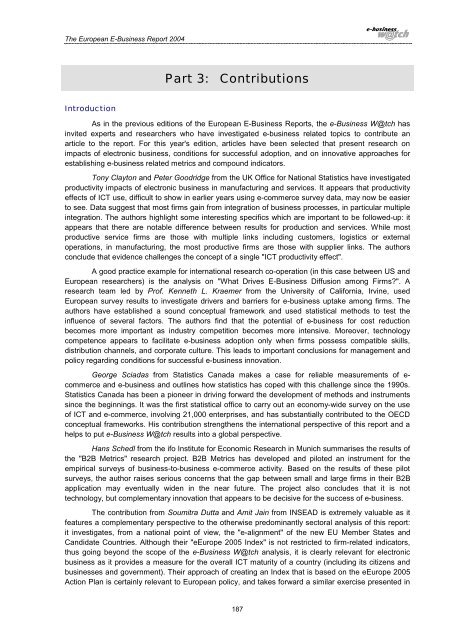The European e-Business Report 2004 - Berlecon Research GmbH
The European e-Business Report 2004 - Berlecon Research GmbH
The European e-Business Report 2004 - Berlecon Research GmbH
Create successful ePaper yourself
Turn your PDF publications into a flip-book with our unique Google optimized e-Paper software.
<strong>The</strong> <strong>European</strong> E-<strong>Business</strong> <strong>Report</strong> <strong>2004</strong>Part 3: ContributionsIntroductionAs in the previous editions of the <strong>European</strong> E-<strong>Business</strong> <strong>Report</strong>s, the e-<strong>Business</strong> W@tch hasinvited experts and researchers who have investigated e-business related topics to contribute anarticle to the report. For this year's edition, articles have been selected that present research onimpacts of electronic business, conditions for successful adoption, and on innovative approaches forestablishing e-business related metrics and compound indicators.Tony Clayton and Peter Goodridge from the UK Office for National Statistics have investigatedproductivity impacts of electronic business in manufacturing and services. It appears that productivityeffects of ICT use, difficult to show in earlier years using e-commerce survey data, may now be easierto see. Data suggest that most firms gain from integration of business processes, in particular multipleintegration. <strong>The</strong> authors highlight some interesting specifics which are important to be followed-up: itappears that there are notable difference between results for production and services. While mostproductive service firms are those with multiple links including customers, logistics or externaloperations, in manufacturing, the most productive firms are those with supplier links. <strong>The</strong> authorsconclude that evidence challenges the concept of a single "ICT productivity effect".A good practice example for international research co-operation (in this case between US and<strong>European</strong> researchers) is the analysis on "What Drives E-<strong>Business</strong> Diffusion among Firms?". Aresearch team led by Prof. Kenneth L. Kraemer from the University of California, Irvine, used<strong>European</strong> survey results to investigate drivers and barriers for e-business uptake among firms. <strong>The</strong>authors have established a sound conceptual framework and used statistical methods to test theinfluence of several factors. <strong>The</strong> authors find that the potential of e-business for cost reductionbecomes more important as industry competition becomes more intensive. Moreover, technologycompetence appears to facilitate e-business adoption only when firms possess compatible skills,distribution channels, and corporate culture. This leads to important conclusions for management andpolicy regarding conditions for successful e-business innovation.George Sciadas from Statistics Canada makes a case for reliable measurements of e-commerce and e-business and outlines how statistics has coped with this challenge since the 1990s.Statistics Canada has been a pioneer in driving forward the development of methods and instrumentssince the beginnings. It was the first statistical office to carry out an economy-wide survey on the useof ICT and e-commerce, involving 21,000 enterprises, and has substantially contributed to the OECDconceptual frameworks. His contribution strengthens the international perspective of this report and ahelps to put e-<strong>Business</strong> W@tch results into a global perspective.Hans Schedl from the ifo Institute for Economic <strong>Research</strong> in Munich summarises the results ofthe "B2B Metrics" research project. B2B Metrics has developed and piloted an instrument for theempirical surveys of business-to-business e-commerce activity. Based on the results of these pilotsurveys, the author raises serious concerns that the gap between small and large firms in their B2Bapplication may eventually widen in the near future. <strong>The</strong> project also concludes that it is nottechnology, but complementary innovation that appears to be decisive for the success of e-business.<strong>The</strong> contribution from Soumitra Dutta and Amit Jain from INSEAD is extremely valuable as itfeatures a complementary perspective to the otherwise predominantly sectoral analysis of this report:it investigates, from a national point of view, the "e-alignment" of the new EU Member States andCandidate Countries. Although their "eEurope 2005 Index" is not restricted to firm-related indicators,thus going beyond the scope of the e-<strong>Business</strong> W@tch analysis, it is clearly relevant for electronicbusiness as it provides a measure for the overall ICT maturity of a country (including its citizens andbusinesses and government). <strong>The</strong>ir approach of creating an Index that is based on the eEurope 2005Action Plan is certainly relevant to <strong>European</strong> policy, and takes forward a similar exercise presented in187
















